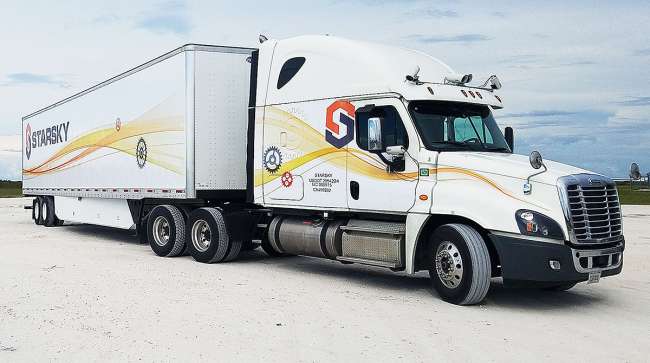Senior Reporter
Starsky Robotics Exits Autonomous Truck Space

[Stay on top of transportation news: Get TTNews in your inbox.]
Starsky Robotics became the first self-driving truck startup to cease operations after raising an estimated $17 million in venture capital in 2018, then failing later to secure more investors, according to people familiar with the matter.
Executives from Starsky did not respond to requests for comment.
“I’ve been expecting a shakeout, and Starsky is the first casualty,” Richard Bishop, an automated vehicle expert and principal of Bishop Consulting, told Transport Topics.
Host Seth Clevenger went to CES 2020 in Las Vegas and met with Rich Mohr of Ryder Fleet Management Solutions and Stephan Olsen of the Paccar Innovation Center to discuss how high-tech the industry has become. Listen to a snippet above, and to hear the full episode, go to RoadSigns.TTNews.com.
Starsky was formed around a plan for moment-by-moment operation of a heavy-duty truck by a remote operator, with the intent of bridging the present freight environment and fully automated driving, he said.
“But full automation came on fast, as has been seen from the startups and original equipment manufacturers now working to commercialize driverless trucking,” Bishop said. “Starsky also went in this direction to some degree and showed promise, but they were in a crowded space.”
A surge of layoffs occurred recently as funding dried up and then the company parked its trucks, according to news reports.
In June, Starsky had completed what it hailed as the first test on a public highway with no human onboard.
“We drove a heavy-duty commercial truck for 9.4 miles along Florida’s Turnpike with no one in it: successfully navigating a rest area, merging onto the highway, changing lanes and maintaining a speed of 55 mph,” founder Stefan Seltz-Axmacher told TT earlier.
Another expert said the industry should be grateful for its innovators.
“A drone approach is not bad, but there is inherent latency there. It’s one thing for the military to build something like that. It is another to build it across your fleet,” said Wally Stegall, technical fellow at The Morey Corp., which serves the electronics market. “But that doesn’t mean in some far future that won’t be part of the system.
“As an industry, we should be grateful for those innovators who have entered and left. But we should also look forward to those who keep moving things forward. We have to expand our view.”
Stegall is an advocate of health-ready components and systems, more sensors with more resolution, plus some big-data processing to push edge computing. Edge computing operates on instant data generated by sensors. Health-ready components are built to interface in that way.
Autonomous vehicles must be looked at as a total system, he said, with edge computing, edge infrastructure interaction and cloud edge interaction.
Want more news? Listen to today's daily briefing:


